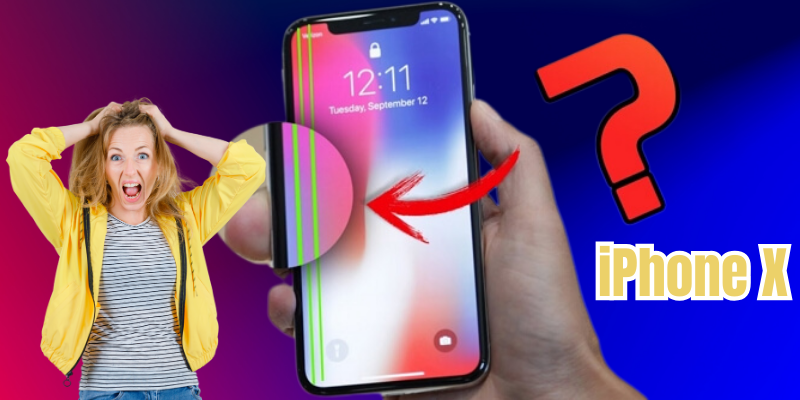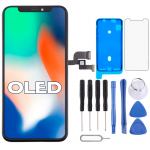Why do lines appear on the screen of my iPhone X?
Publicado por MariaWhy are there lines on my iPhone X screen? ?
What a nuisance! If you're seeing those annoying lines on your iPhone X screen, you know how frustrating it can be. Whether they're green, purple, white, or multicolored, these lines are often a clear sign that something is wrong with your device's hardware. At iLevante.com, we understand your concern and want to help you diagnose the problem and, if possible, find the solution. Get ready, because we're going to unravel the mysteries behind the lines on your iPhone X screen.
Your iPhone X is an impressively engineered device, but like any technology, it is susceptible to failures, especially in its most exposed component: the screen. These lines are rarely a software issue, so restarting the phone or updating iOS generally won't fix them. In the vast majority of cases, we're dealing with a hardware problem.
Common causes of lines on the iPhone X screen: Beyond a simple drop! ?
When lines appear on the iPhone X OLED Display (Like Original), the first question you ask yourself is: "What happened?" Often, the answer is more complex than a simple incident. Here we explain the most common reasons and which parts of your iPhone X might be affected.
Physical damage: The most obvious culprit ?
Let's not kid ourselves, bumps and drops are the main "killers" of screens. Your iPhone X, with its beautiful OLED screen, is particularly sensitive to impacts. When it falls, the impact can damage individual pixels or internal screen connections, manifesting as vertical or horizontal lines. Sometimes, the screen may appear intact on the outside, but the internal damage is already done. Excessive pressure on the screen or a twist of the chassis can also cause this type of damage.
- Direct impact: A hard fall can fracture the internal layers of the OLED screen, causing pixels not to display information correctly.
- Pressure: Keeping the phone in a tight pocket or sitting on it can exert enough pressure to damage the panel.
In these cases, the problem is almost always with the screen itself (display assembly). It's the part you'll need to replace to get your iPhone X back to normal operation.
Liquid damage: The silent enemy ?
Although the iPhone X has some water resistance, it is not waterproof, and exposure to liquids can be devastating. Water or any other fluid can seep in and cause corrosion or short circuits in internal components, including the screen flex cables or even the motherboard. The Liquid Contact Indicators (LCI) inside your iPhone will turn red if there has been exposure.
If liquid has affected the screen flex or the connectors on the motherboard (also known as the logic board), you'll see lines, flickering, or even a completely black screen. Corrosion in the connectors can prevent the video signal from reaching the screen properly.
Depending on the extent of the damage, you might need:
- A new screen assembly (if the damage is localized to the screen flex).
- A cleaning or repair of the motherboard (if the connectors or video circuits are corroded).
Internal hardware issues: When it's not just the screen ??
Sometimes, the lines on your screen aren't directly caused by the panel but by other internal components responsible for sending the video signal or controlling the lighting. This is where things get a bit more technical, but it's key for an accurate diagnosis.
The screen flex: A vital connection ?
The screen of your iPhone X connects to the motherboard via several flexible cables (flex cables). These cables are delicate and contain numerous conductive threads. Damage to one of these flex cables (from a drop, mishandling when opening the phone, or simply wear and tear) can interrupt the video signal, resulting in lines or areas without an image. The main display flex is usually integrated into the screen assembly itself, so it's not a part that can be replaced separately. If this flex is damaged, a complete screen replacement will be required.
Issues on the motherboard (or logic board): The brain of your iPhone ?
The motherboard is the heart of your iPhone X and contains specific chips and circuits that manage the image on the screen. If any of these components fail, the result can be lines, flickering, or even a total lack of image. Here are some critical points:
- Backlight Circuit: Although OLED screens like the iPhone X's don't have a traditional backlight like LCDs, they do have a backlight circuit that manages power for each pixel. If this circuit, which includes the IC U5600, filters (FL3901, FL3902, FL3903), coils (L5600), and diodes (D5600), suffers damage (e.g., from a short circuit due to liquid or a drop), it can cause brightness lines or even make the screen completely dark or partially lit.
- Display Driver IC: This chip is responsible for sending precise electrical signals to the screen's pixels. A failure in this driver can cause constant line patterns, color distortion, or visual artifacts.
- FPC connectors on the motherboard: These are the physical connectors where the screen flex cables plug in. If these pins are bent, broken, or corroded, the connection will be compromised, resulting in lines or no image.
- Electrostatic Discharge (ESD): Even a small static discharge can damage sensitive circuits on the motherboard, leading to screen failures.
If the problem lies in the motherboard, the repair is more complex and generally requires microsoldering tools and advanced technical knowledge. It's not a repair recommended for the average user. In these cases, the most viable solution is often motherboard repair by a specialized technician or, in extreme cases, replacement of the motherboard.
What parts can be replaced to fix the lines? ??
The good news is that, in most cases, the solution involves replacing a part.
- Complete iPhone X Screen Assembly: This is the most commonly replaced part. It includes the OLED panel, the digitizer (for touch), and the front glass. If the lines are caused by a drop, pressure, or a damaged screen flex, a screen replacement will solve the issue. At iLevante.com, you'll find high-quality replacement screens for your iPhone X.
- Motherboard Repair: If it's confirmed that the issue is with the motherboard (e.g., in the backlight circuit or the connectors), the solution is to repair these specific components through microsoldering. This task is delicate and should be performed by professionals.
Are you ready to change your iPhone X screen? A basic guide! ?
Changing the screen of an iPhone X is one of the most common repairs, and with the right tools and patience, you can do it yourself. However, keep in mind that it is a delicate repair and there is always a risk of damaging other components.
Tools you'll need: ?
- Precision screwdrivers: Pentalobe (P2), Tri-Point (Y0.6), and Phillips (PH00).
- Suction cup: To lift the screen.
- Plastic opening picks and Spudger: To separate components and disconnect flex cables.
- Tweezers: To handle screws and small parts.
- Heat gun or hairdryer: To soften the screen adhesive.
- Replacement screen adhesive: Essential to restore water resistance.
Basic steps for screen replacement: ?
- Turn off your iPhone X and disconnect the battery: This is the most important step to avoid short circuits! Remove the two Pentalobe screws at the bottom of the phone.
- Apply heat: Use the heat gun (with caution) around the edges of the screen to soften the adhesive.
- Open the screen: Use the suction cup to lift the bottom part of the screen, and with the plastic picks, slide around the edges to separate the adhesive. Open it like a book, from right to left.
- Disconnect the battery and the screen: Using the Tri-Point screwdriver, remove the screws holding the metal bracket over the battery and screen connectors. Disconnect the battery flex first, then the screen and digitizer flex cables with the spudger.
- Transfer components: This is the most critical step: you'll need to transfer the ear speaker/front sensor assembly (where the Face ID is housed) from your old screen to the new one. This piece is extremely fragile, and damaging it can permanently disable the Face ID function. Do this very carefully, removing the Phillips screws and using tweezers to gently peel off the flex cable.
- Connect the new screen: Connect the new screen and digitizer flex cables, then the battery flex. Screw the connector brackets back in place.
- Test the screen: Before sealing, turn on the iPhone to ensure the new screen works correctly, the touch is responsive, and there are no lines.
- Seal and reassemble: If everything is fine, turn off the iPhone again, apply the new screen adhesive, and carefully close the device. Ensure the edges fit perfectly. Screw the two bottom Pentalobe screws back in place.
Common problems during repair and how to prevent them ??
Performing an iPhone X repair at home has its risks. Knowing them will help you be more cautious and minimize the chances of a disaster:
- Disabling Face ID: This is the number one risk! The ear speaker and front sensor assembly (where Face ID is located) is very delicate and cryptographically paired with the motherboard. Any damage to the Face ID sensors (such as the flood illuminator or dot projector) during the transfer or when handling the screen can permanently disable this function. Be extremely careful when handling this piece. If you're not confident, it's better to seek professional help.
- Damage to other flex cables: Besides the screen flex cables, there are other delicate cables inside (like the battery, charging, power button). An accidental tug or pinch with a tool can damage them, causing additional problems.
- Lost or misplaced screws: The screws in the iPhone are tiny and varied. Losing or mixing them up can lead to improper reassembly of the phone or even damage to the motherboard if you use a screw that's too long in the wrong place. Organize them carefully.
- Compromising water resistance: The iPhone X has an adhesive seal that gives it some water resistance. When opening it, this seal is broken. It's crucial to apply a new quality adhesive during reassembly if you want to maintain this feature.
- Screen not working after replacement: This can happen for several reasons: a flex connector is not properly plugged in, there is dust or dirt on the connectors, or the motherboard pins are bent. Check all connections carefully before closing the phone.
- Battery damage: Disconnecting the battery incorrectly or puncturing it with a tool can be dangerous, causing leaks or even fires. Always disconnect the battery first and carefully.
- Static: A static discharge can damage sensitive internal components. Work in a static-free environment and consider using an anti-static wrist strap.
If the idea of opening your iPhone X seems overwhelming or you don't feel confident, remember that at iLevante.com, we not only offer the spare parts and iPhone X components you need but also have resources and guides to help you. And if you prefer to leave it to the experts, you can always go to a trusted repair service in Valencia or your local area.
We hope this article has provided you with the information you were looking for to understand why lines appear on your iPhone X screen and what you can do about it. Don't hesitate to visit our website to find the iPhone X replacement screen you need or any other iPhone X part!
Find your iPhone X spare parts at iLevante.com ?
At iLevante.com, we specialize in offering high-quality parts to repair your iPhone X, from iPhone X screens to iPhone X batteries and essential tools. Our goal is to help you give your device a second life effectively and economically. Explore our catalog and restore clarity to your iPhone X screen!









